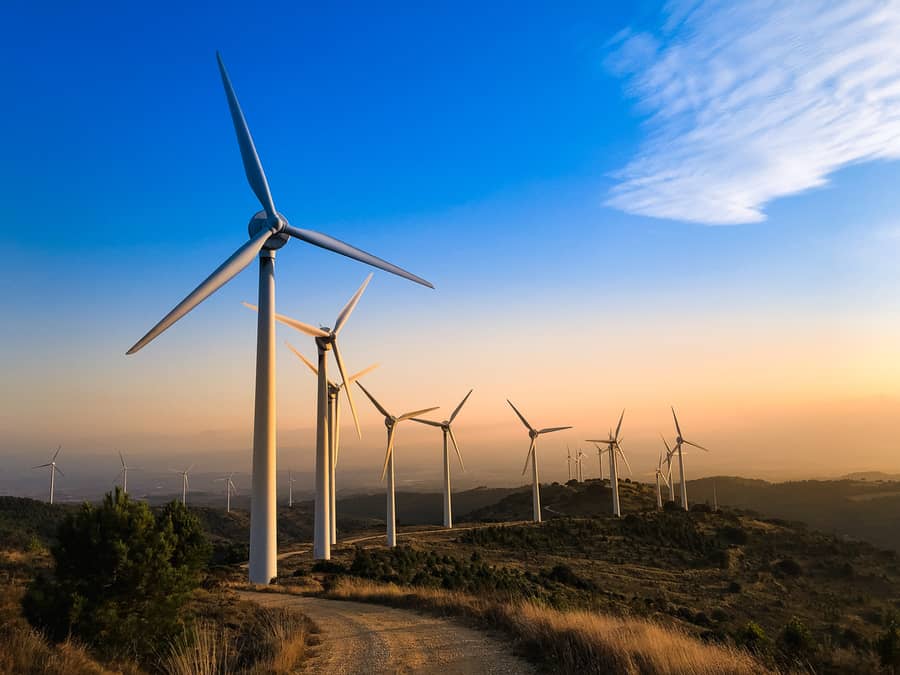
Wind energy continues to see strong growth, solid performance, and low prices in the U.S., according to a report released by the U.S. Department of Energy (DOE) and prepared by Lawrence Berkeley National Laboratory (Berkeley Lab). With levelized costs of just over $30 per megawatt-hour (MWh) for newly built projects, the cost of wind is well below its grid-system, health, and climate benefits.
“Wind energy prices – particularly in the central United States, and supported by federal tax incentives – remain low, with utilities and corporate buyers selecting wind as a low-cost option,” said Berkeley Lab Senior Scientist Ryan Wiser. “Considering the health and climate benefits of wind energy makes the economics even better.”
Key findings from the DOE’s annual “Land-Based Wind Market Report” include:
- Wind comprises a growing share of electricity supply. U.S. wind power capacity grew at a record pace in 2020, with nearly $25 billion invested in 16.8 gigawatts (GW) of capacity. Wind energy output rose to account for more than 8% of the entire nation’s electricity supply, and is more than 20% in 10 states. At least 209 GW of wind are seeking access to the transmission system; 61 GW of this capacity are offshore wind and 13 GW are hybrid plants that pair wind with storage or solar.
- Wind project performance has increased over time. The average capacity factor (a measure of project performance) among projects built over the last five years was above 40%, considerably higher than projects built earlier. The highest capacity factors are seen in the interior of the country.
- Turbines continue to get larger. Improved plant performance has been driven by larger turbines mounted on taller towers and featuring longer blades. In 2010, no turbines employed blades that were 115 meters in diameter or larger, but in 2020, 91% of newly installed turbines featured such rotors. Proposed projects indicate that total turbine height will continue to rise.
- Low wind turbine pricing has pushed down installed project costs over the last decade. Wind turbine prices are averaging $775 to $850/kilowatt (kW). The average installed cost of wind projects in 2020 was $1,460/kW, down more than 40% since the peak in 2010, though stable for the last three years. The lowest costs were found in Texas.
- Wind energy prices remain low, around $20/MWh in the interior “wind belt” of the country. After topping out at $70/MWh for power purchase agreements executed in 2009, the national average price of wind has dropped. In the interior “wind belt” of the country, recent pricing is around $20/MWh. In the West and East, prices tend to average $30/MWh or more. These prices, which are possible in part due to federal tax support, fall below the projected future fuel costs of gas-fired generation.
- Wind prices are often attractive compared to wind’s grid-system market value. The value of wind energy sold in wholesale power markets is affected by the location of wind plants, their hourly output profiles, and how those characteristics correlate with real-time electricity prices and capacity markets. The market value of wind declined in 2020 given the drop in natural gas prices, averaging under $15/MWh in much of the interior of the country; higher values were seen in the Northeast and in California.
- The average levelized cost of wind energy is down to $33/MWh. Levelized costs vary across time and geography, but the national average stood at $33/MWh in 2020—down substantially historically, though consistent with the previous two years. (Cost estimates do not count the effect of federal tax incentives for wind.)
- The health and climate benefits of wind in 2020 were larger than its grid-system value, and the combination of all three far exceeds the current levelized cost of wind. Wind generation reduces power-sector emissions of carbon dioxide, nitrogen oxides, and sulfur dioxide. These reductions, in turn, provide public health and climate benefits that vary regionally, but together are economically valued at an average of $76/MWh-wind nationwide in 2020.
- The domestic supply chain for wind equipment is diverse. For wind projects recently installed in the U.S., domestically manufactured content is highest for nacelle assembly (over 85%), towers (60% to 75%), and blades and hubs (30% to 50%), but is much lower for most components internal to the nacelle.
Berkeley Lab’s contributions to this report were funded by the U.S. Department of Energy’s Wind Energy Technologies Office.
# # #
Founded in 1931 on the belief that the biggest scientific challenges are best addressed by teams, Lawrence Berkeley National Laboratory and its scientists have been recognized with 14 Nobel Prizes. Today, Berkeley Lab researchers develop sustainable energy and environmental solutions, create useful new materials, advance the frontiers of computing, and probe the mysteries of life, matter, and the universe. Scientists from around the world rely on the Lab’s facilities for their own discovery science. Berkeley Lab is a multiprogram national laboratory, managed by the University of California for the U.S. Department of Energy’s Office of Science.
DOE’s Office of Science is the single largest supporter of basic research in the physical sciences in the United States, and is working to address some of the most pressing challenges of our time. For more information, please visit energy.gov/science.
from ScienceBlog.com https://ift.tt/2WDNJIs




No comments:
Post a Comment